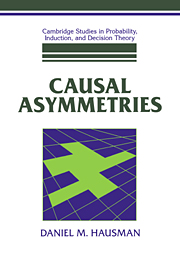Book contents
- Frontmatter
- Contents
- List of Figures
- Acknowledgments
- Introduction: Causation and its Asymmetries
- 1 Metaphysical Pictures and Wishes
- 1* Transfer Theories
- 2 Is Causation a Relation Among Events?
- 3 Causation, Regularities, and Time: Hume's Theory
- 4 Causation and Independence
- 4* Causation, Independence, and Causal Connection
- 5 Agency Theory
- 5* Causal Generalizations and Agency
- 6 The Counterfactual Theory
- 6* Independence and Counterfactual Dependence
- 7 Counterfactuals, Agency, and Independence
- 7* Agency, Counterfactuals, and Independence
- 8 Causation, Explanation, and Laws
- 8* Causation, Explanation, and Independent Alterability
- 9 Probabilistic Causation
- 10 Causation and Conditional Probabilities
- 10* Causal Graphs and Conditional Probabilistic Dependencies
- 11 Intervention, Robustness, and Probabilistic Dependence
- 11* Interventions and Conditional Probabilities
- 12 Operationalizing and Revising the Independence Theory
- 12* Probability Distributions and Causation
- 13 Complications and Conclusions
- Appendix A Alphabetical List of Propositions
- Appendix B List of Theorems
- References
- Index
10 - Causation and Conditional Probabilities
Published online by Cambridge University Press: 20 April 2010
- Frontmatter
- Contents
- List of Figures
- Acknowledgments
- Introduction: Causation and its Asymmetries
- 1 Metaphysical Pictures and Wishes
- 1* Transfer Theories
- 2 Is Causation a Relation Among Events?
- 3 Causation, Regularities, and Time: Hume's Theory
- 4 Causation and Independence
- 4* Causation, Independence, and Causal Connection
- 5 Agency Theory
- 5* Causal Generalizations and Agency
- 6 The Counterfactual Theory
- 6* Independence and Counterfactual Dependence
- 7 Counterfactuals, Agency, and Independence
- 7* Agency, Counterfactuals, and Independence
- 8 Causation, Explanation, and Laws
- 8* Causation, Explanation, and Independent Alterability
- 9 Probabilistic Causation
- 10 Causation and Conditional Probabilities
- 10* Causal Graphs and Conditional Probabilistic Dependencies
- 11 Intervention, Robustness, and Probabilistic Dependence
- 11* Interventions and Conditional Probabilities
- 12 Operationalizing and Revising the Independence Theory
- 12* Probability Distributions and Causation
- 13 Complications and Conclusions
- Appendix A Alphabetical List of Propositions
- Appendix B List of Theorems
- References
- Index
Summary
In chapter 4 I made the operationalizing assumption that there are causal connections among events if and only if there are probabilistic dependencies in the background circumstances among the relevant properties or variables. If this assumption is a reasonable approximation, then the claims about causal asymmetry made in chapters 4–7 have implications concerning probability distributions, which deserve further scrutiny. This chapter begins this scrutiny by exploring David Papineau's theory relating causation to conditional probabilistic dependencies.
The Fork Asymmetry
Suppose event types a and b are probabilistically dependent on one another:
1. Pr(AB) > Pr(A)·Pr(B).
Suppose further that
2. a and b are not related as cause and effect.
Then, according to Hans Reichenbach, there exists an event type c satisfying the following conditions:
3. Pr(AC) > Pr(A)·Pr(C)
4. Pr(BC) > Pr(B)·Pr(C)
5. Pr(AB/C) = Pr(A/C)·Pr(B/C)
6. Pr(AB/~C) = Pr(A/~C)·Pr(B/~C)
7. Tokens of kind cprecede tokens of kinds a and b.
8. Tokens of kind c are common causes of tokens of kinds a and b.
The probabilistic dependence between a and b is explained by the existence of the common cause c. Reichenbach proves that if none of the probabilities is one or zero, then 3–6 entail 1. This proof is given in chapter 4*, pp. 76–7.
7 or 8 is called in the literature “the fork asymmetry”: the causal arrows point away from the event type that does the screening-off and toward the future. 7 might be called the temporal fork asymmetry, while 8 might be called the causal fork asymmetry. There can be events of kind c satisfying 3–6 that are common effects of a and b and that succeed them in time, but only when there are also common (preceding) causes.
- Type
- Chapter
- Information
- Causal Asymmetries , pp. 207 - 216Publisher: Cambridge University PressPrint publication year: 1998



